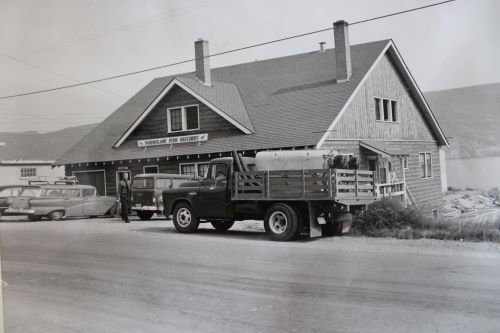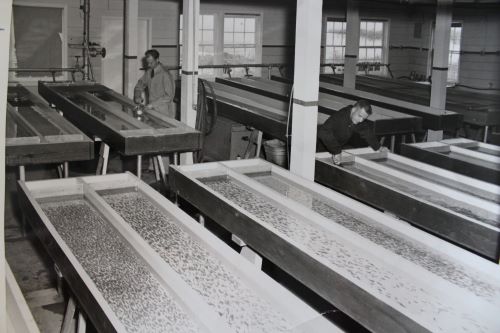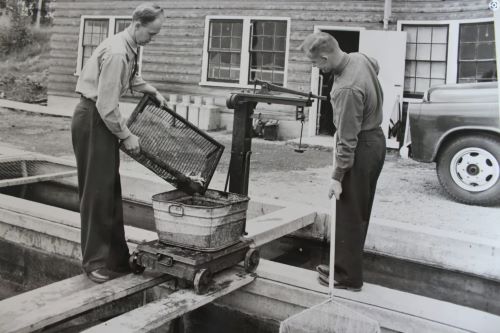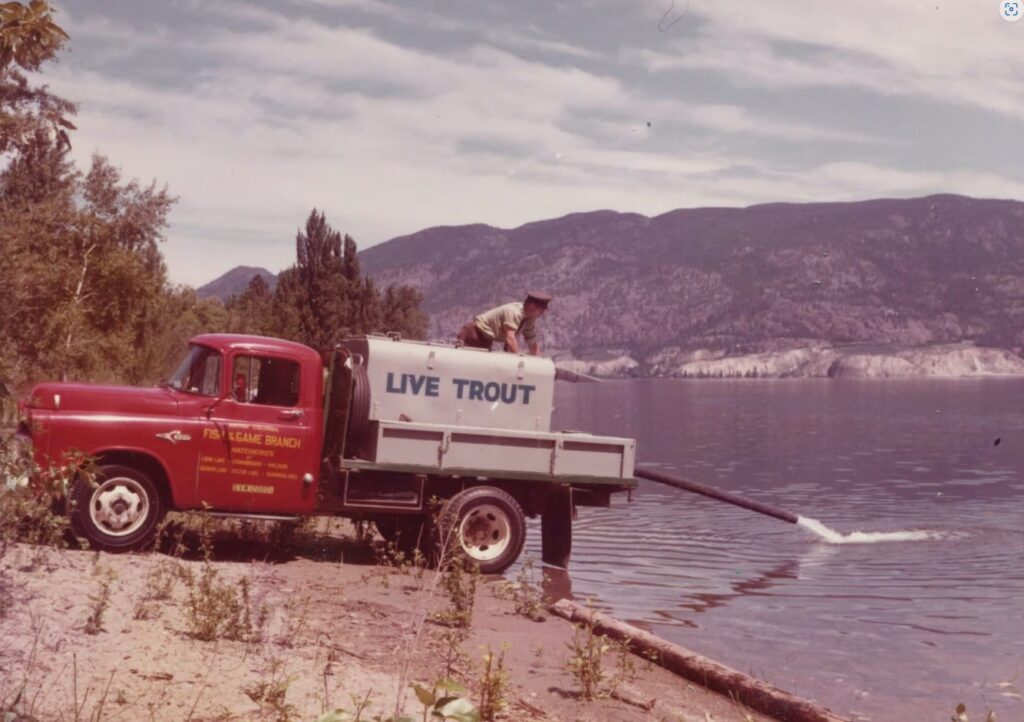Publish date: October 7, 2021
How the Freshwater Fisheries Society of BC came to be
Fish culture and stocking have a long history in British Columbia’s fisheries programs, with government-led activities going back to the early 1900s. Fish stocking supports a diversity of fisheries objectives, including harvest and angling opportunities; commercial aquaculture interests; and species recovery initiatives.
In terms of government-supported programs that stock fish back into watersheds, hatchery production can be broadly divided according to jurisdiction in B.C. The provincial government oversees hatchery production of all freshwater fish species for freshwater recreational fisheries, as well as some limited conservation initiatives. The Freshwater Fisheries Society of BC delivers the freshwater hatchery program on behalf of the province. The federal Department of Fisheries and Oceans oversees all stocking for salmon fisheries (commercial, recreational, and aboriginal), as well as salmon conservation initiatives. Hatchery salmon are produced via a combination of federal- and community-run facilities.
Hatcheries and freshwater recreational fish management in B.C.
Originally, the federal government was responsible for the management of all fisheries in the province. This changed in 1937, when the ownership of hatchery facilities for recreational fish species was officially transferred to British Columbia. The federal government retained jurisdiction over all marine, coastal, and inland fisheries in the country (under the Fisheries Act), but transferred administrative responsibilities to B.C. to oversee freshwater recreational fisheries – including the delivery of hatchery programs to stock lakes and rivers.
Well before then, various trout species were already being cultured in B.C. to stock lakes and rivers in support of freshwater recreational fisheries. Individuals and agencies were moving fish around even before the 1900s – a dubious activity that might explain the presence of some species in unexpected waterbodies (and now an illegal activity without a special licence, given the serious conservation impacts it can have). However, since the Province took ownership of stocking for recreational purposes in 1937, a far more rigorous program has developed, with ever-improving expertise and technologies.
The creation of the Freshwater Fisheries Society of BC
The freshwater fisheries hatchery program was operated as part of the provincial fisheries program by the government of B.C. until 2003, when the government determined this program could be delivered externally via a newly created non-profit organization, the Freshwater Fisheries Society of BC. The ownership of all freshwater hatcheries was transferred to the Freshwater Fisheries Society at this time. While the Society maintains all aspects of fish culture from breeding to release, they work very closely with provincial fisheries biologists, who determine what fish will go where (including decisions regarding species, strain, ploidy, and numbers per lake). The Society now relies almost entirely on freshwater angling licence revenue to deliver the recreational stocking program, as well as several other fisheries-related initiatives. While the stocking program costs approximately ten million dollars a year to support, the social and economic benefits to local communities are significant, with freshwater anglers spending almost $500 million to go fishing (see the latest BC Freshwater Sport Fishing Economic Impact Report).
Freshwater Fisheries Society of BC hatcheries
The Freshwater Fisheries Society of BC’s Summerland Trout hatchery, located in the Okanagan region, is the oldest continuously run trout hatchery in B.C. Officially, this location began producing trout after 1927, when the federal government purchased the lakeside property and converted an old on-site powerhouse to a hatchery facility. A local freshwater spring ensured the hatchery had consistent water flow and temperature. In 1937 (the same year that B.C. took over culture activities for all inland species), the Province received this hatchery from the federal government.



Since then, several other freshwater hatchery facilities were developed for trout production. Four of these (now also owned by the Freshwater Fisheries Society of BC) remain today, and include the Fraser Valley Trout Hatchery (purchased in the mid-1960s by the Province, and upgraded significantly in 1977), Vancouver Island Trout Hatchery (opened in 1982, and significantly upgraded in 1993), Clearwater Trout Hatchery (opened in 1997), and Kootenay Trout Hatchery (opened in 1966).
| 1927 | The concrete powerhouse in Summerland is converted into a federal hatchery. | |
| 1928 | The first rainbow trout eggs from Pennask Lake are brought to the hatchery. | |
| 1937 | The Province takes over all fish culture activities for inland recreational species. | |
| 1948 | The converted powerhouse in Summerland is replaced by the current structure. The facility becomes the first permanent trout hatchery for the Province. | |
| 1960’s | The Province takes ownership of the Fraser Valley Trout Hatchery. | |
| 1966 | The Kootenay Trout Hatchery opens. | |
| 1982 | The Vancouver Island Trout Hatchery opens. | |
| 1997 | The Clearwater Trout Hatchery opens. | |
| 2003 | Ownership of the provincial trout hatcheries is converted to the newly formed Freshwater Fisheries Society of BC. | |
| 2014 | The Nechako White Sturgeon Conservation Centre opens in Vanderhoof – the only Society-run hatchery dedicated wholly to the conservation of white sturgeon. At present, no fish are produced for recreational fisheries at the facility. |
During the early Salmon Enhancement Program days in the 1970s, at least some of these hatcheries received funding to support searun trout production. This funding enabled them to upgrade facilities and technologies significantly. The searun trout programs have since been reduced or terminated completely due to poor success, and production has focussed on establishing a diversity of trout, char, and kokanee stocks to suit various lake environments and angler preferences. These hatcheries now produce over six million rainbow, cutthroat, and brook trout, and kokanee to be released into approximately 800 small lakes in B.C. each year.
Pacific Salmon hatcheries in B.C.
Salmon hatcheries in B.C. have also been around for several decades, but they really ramped up in 1977 when the federal government implemented the Salmon Enhancement Program (SEP). The intent of SEP was to double the number of salmon available for harvest in response to a massive decline of Pacific salmonid stocks observed up and down the west coast of British Columbia. This collaborative initiative with the Province included all five species of Pacific salmon (chinook, coho, sockeye, chum, and pink) as well as searun trout (steelhead and cutthroat). The result was a significant increase in hatchery fish production, with large numbers of streams and lakes receiving hatchery-origin juvenile fish. The expectation was that these fish would emigrate to sea, grow, and return, providing significant socioeconomic benefits to fisheries as well as enhancing wild stocks.
While ocean conditions in the 1980s supported enhanced marine survival for salmon, with large numbers of fish returning, conditions took a definite downswing by the 1990s. Major declines became apparent in many regions despite major hatchery production. Researchers began to question earlier assumptions, and the efficacy of fish culture to enhance stocks. In some cases, it became evident that hatchery fish could do more harm than good to wild stocks.
Since that time, hatchery practices for searun salmonids have advanced significantly. Many programs have implemented a more conservation-based approach that considers impacts to wild stocks as well as the capacity of natural systems to support large numbers of hatchery fish. Unfortunately, there are few good-news stories with regards to recovery of searun salmon these days; the debate about negative impacts of hatchery fish rages on. SEP programs continue to produce hatchery juveniles for release. However, the numbers of wild salmon and steelhead continue to decline in many streams in almost all coastal regions.
It’s difficult to identify the smoking gun in many cases. The cumulative impacts of habitat loss and alteration, water use, climate change, overharvest, and even hatchery impacts may be just too much for some wild populations. Many researchers believe that the overriding factor is ocean survival – both nearshore and offshore – be it due to climate conditions or removal (by marine predators and humans). Regardless, most agree that the focus on ocean survival should not undermine efforts to restore and protect freshwater habitats. Salmon hatcheries may temporarily support larger numbers of adult fish in the ocean, but unless the causes for declines are identified and addressed, natural production in wild populations will not improve.
How salmon and trout stocking programs differ
The objectives for salmon- versus trout-stocking programs in B.C. are very different. Salmon programs are highly complex; they deal with species that have both freshwater and saltwater life stages that run the gauntlet in both habitats during migration as juveniles and then again as adults. With limited information about specific causes for or locations of poor survival, the ocean component remains somewhat of a black box. Salmon programs may be put in place to enhance and provide fisheries, to compensate for lost salmon production due to habitat loss, and/or to rebuild populations in the wild. These can be challenging objectives, especially where causes for decline are not clear or have not been remedied.
The objectives for the provincial stocking program are almost entirely limited to providing and enhancing recreational freshwater fisheries in small lakes using hatchery-reared trout, char, and kokanee. Many small lakes cannot otherwise support fisheries. This objective is straightforward and can be successfully delivered using modern fisheries science to determine the most suitable fish to stock into a specific system. At present, only a small handful of programs still stock anadromous steelhead and cutthroat into coastal rivers, again with the explicit intent of providing angling opportunities, not to rebuild wild populations. Finally, the Province oversees a couple of recovery-based hatchery initiatives that the Freshwater Fisheries Society of BC supports, but these are the exception, and at present, limited to white sturgeon.
Technological advances for freshwater stocking
In every aspect of fish culture, technologies have advanced greatly to create hatchery-fish strains that are most suited to the environment into which they will be stocked. Fish health practices are stringent. To ensure no diseases are present, the Freshwater Fisheries Society fish health lab assesses every batch of fish before it is released into the natural environment.
Advances have also been made to address conservation concerns related to hatchery fish breeding with wild fish. To prevent interbreeding, the intent is to stock only sterile fish where they may interact with native fish of the same species.
On-site fish husbandry techniques are continually improving as well. Not only do these advances help improve survival in the hatchery, they also provide a more robust fish population once the fish are released into a lake. The result is a diversity of healthy stocking options that have been tailored to produce quality fisheries in different small-lake settings ranging from high-use, “put-and-take” urban lakes to remote wilderness lakes only accessible by foot.
Author: Sue Pollard, Freshwater Fisheries Society of BC
